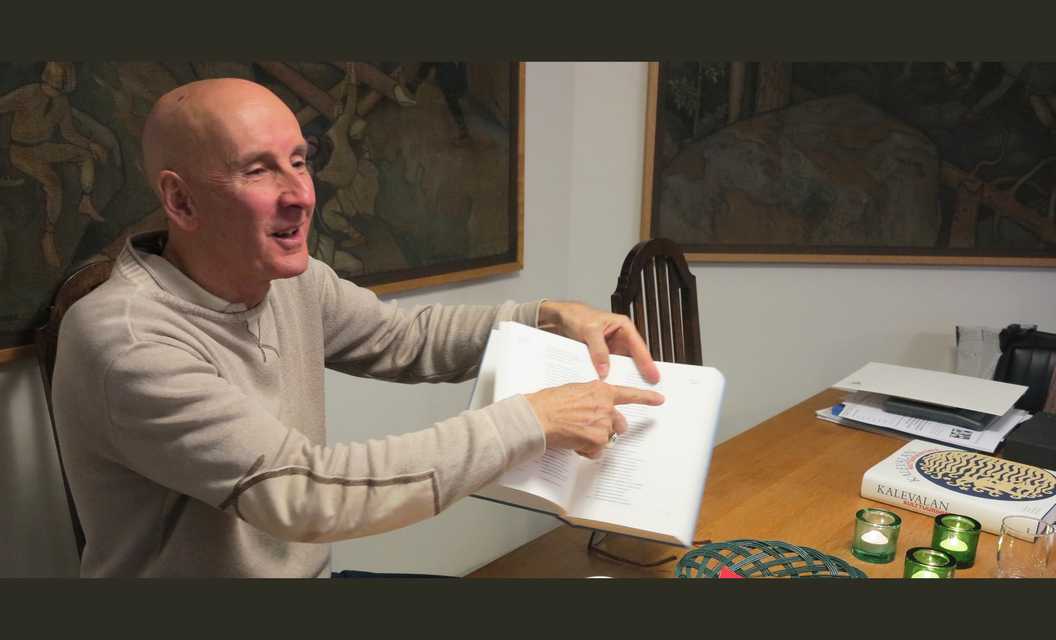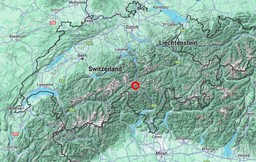“Alégar” is how we greet each other in Lévéntinéss áut: it means joyful. In Rumantsch Grischun, they say “alégra”.
While returning to Europe, after having studied in US, on a ten-day long boat trip from New York to Rotterdam I joined a daily four-hour Finnish language class for American students coming to Finland. It was fascinating, I liked the non-Indo-European difference. Since then (1968) I have spoken it every day as I moved to Helsinki in 1970.
How I got aquainted with the Kalevala
I first ran into the Kalevala through a friend living in Kauniainen on Sailonkuja. He was related to Alpo Sailo, the sculptor who has made for example the statue of the famous Karelian runo singer Larin Paraske. For several years, I spent many evenings in my friend’s big log house in front of the fireplace in the living room (tupa) surrounded by Sailo’s sculptures. In the mid-seventies at a seminar, mythologist Joseph Campbell got me more curious about the Kalevala. I liked the idea of an epic poem considered to be the closest to nature and everyday life. I never really could identify with the old Greek ones I learned about at school.
My translating of the Kalevala, originally, might have been an alternative to a doctoral thesis on language, which I was considering. It took me a long time before I returned to the poem and began to translate it. Our language had no texts except for poetry. With the translation of the Kalevala, I also thought to nourish the literature in our valley’s language. We have no runolaulu (runo song) tradition, which made me feel sad. This translation is an appreciation for living with Finns, and an homage to the language of the valley of my origin.
I had the privilege of sleeping one year by the hearth (pankolla) of a two-hundred years old log-house. That experience and helping the neighboring farmer in the plowing of his fields (kyntäminen), I thought, was about an intrinsic aspect in the Kalevala cultural landscape as well as wearing lapikkaat (boots) which had to be repaired with wooden nails. Gradually, I became grounded enough to be on my way to identify with archaic Finnish life and playing with its fantasy.
I wanted to translate the Kalevala in its original form without the help of other translations, as I was relying on having been in Finland for about half a century. That would give me genuine enough advantages compared to other translations made from a distance, which might fall short in capturing the nuances of Finnish culture and its attitudes.
I felt that there was no point in translating the Kalevala and sensing that my job was going to be worse than the original. One often hears “you cannot get the Kalevala feeling” or “it will never be the same”. Well, to me it would have been worthless to launch myself on a mediocre translating adventure, only to end up with abandoning myself to something which could turn out to be a mission impossible.
The old language archived in my mind
My translation is as close to the original as it can be, not the same thing. It has to be different as it is in another language. I think that a translation is not a reproduction, but rather a transformation mirroring the original. In that way meanings are being reborn in emotions and images with a similar music while the metamorphosis rolls ahead. Maybe it is close to the art of revelation in the way it makes the unknown known, by recreating the art of others. I believe that any lingua franca or academic language suits poorly to making a touching translation of the Kalevala. Léventinéss áut is a mountain-valley language, a very frank one, and adequate for the job. The hermeneutic aspect in doing the translation was also considered.
As I live in Finland, primarily, Leventinéss áut has stayed with me in the form it had in the days of my childhood and youth, living in the valley. I had the advantage of having retained certain old ways of saying, less contaminated by the media language evolved since I left in the mid-sixties. I had more of a straight connection to how the grandfathers spoke once upon a time, i.e. people who did outdoor work. Having had old parents and friends to ask from was helpful, but I wanted to connect with even older ones in order to make sure that the words I remembered were indeed such. I was eager to hear their more archaic expressions and synonyms. It was a very dialogical process, and strangely enough, I was not the only one who thanked for the discoveries. Some very old people were also rediscovering ancient words they had not heard in ages, since fathers and grandmothers had died long ago, and the cultural landscape had changed. For instance: no more work in the woods, mountains and other milieus; working tools had become relics for museums and/or left in the barns to amaze kids who would bump into them.
During the years of practicing, and in the course of my translating years (14), I was growing more expert about the job, and confident that I knew what was important for completing it well. The technical, the artistic, the metrics, the musical, the rhythm and the contextual aspects were coming together in a wholesome way that satisfied my ears and those of the people I was reading it to. I even read the whole Kalevala in the telephone to a woman in her 90ies who had poor eye sight. I knew it from the beginning that the Kalevala language translated into my language could not satisfy me, if people couldn’t recite it with passion. In fact, I was, without noticing, reminding myself that the Kalevala was originally in a runolaulu form – sung and not just written poetry (I later rediscovered that while reciting my translation on the CD version which came out five years later).
Lévéntinéss aut – language of only 1500 people
Leventinéss áut is the closest language to Rumantsch Grischun (particularly the Sursilvann version) also for the way it sounds. It is a variant remnant of the old Rhaetian languages. It is still spoken above one thousand two hundred meters high in the Leventina valley.
The language has no more than 1,500 speakers of varying proficiency levels. It is, like the Rumantsch variants, a language which has sounds like “sg” sounding like the French “j” , “sh” and“scch” like some Slavic languages, and “k” similar to the Swedish like in källa (spring). It has adopted and adapted idioms and loanwords from Swiss-Italian, Swiss-French and Swiss-German languages. I’ve always liked the way elderly people speak our language – earlier I particularly loved the way locals who had returned from living a life in America spoke it, in an out-dated form pronounced with an English accent. I will never forget an old man, a wonderful storyteller I often visited with my father. His house was full of hunting trophies, including eagles which he hunted with a big owl kept in his backyard. As kids we were enchanted when looking at the bird with its round, penetrating eyes, turning its head 360 degrees around.
It has been a challenge and an adventure to find the best phraseological terms for translating the Kalevala. Words can be powerful, but even more so when connected in a sentence which sounds “spot on” in order to transmit the attitude of the original language on top of the meaning. Words inform and can transform fantasies and/or pictures bound to the Lebenswelt of the one hearing or reading them. Together, words create a chain of meanings evolving through time, as they are involved in a constant metamorphosis when one reads them or speaks them. Listening and reading is being formed and reformed over and over in the labyrinth of interpretations, and there is no one single and right way to succeed or proceed.
Creating words
The music and fragrance of the translation reflect the essence of Kalevala, its original Zeitgeist. To me, it crystallizes those life forces that can be true and relevant to those who read or listen to Kalevala, even in the Léventinéss áut language. What happened in the past lives of the real and/or imaginary people in the Kalevala could have happened in our valley in similar ways. This also because the same trees, bushes, flowers, berries, some fish and animals in the woods, other milieus and rural lifestyle are part of my childhood’s atmosphere.
Of course, there are mistakes in the printed book. Primarily they are technical accidents: when pushing one computer key, some accents turned the other way around. It’s without intent, and that was unfortunate, but it had to be swallowed. As with the Hells Angels motorcycle club, some people remark that there’s an apostrophe missing after “Hell”. Yet, the members of the association will say that you need it, they don’t. A native Leventinéss would be able to read the Kalevala fluently even if it was written all without accents.
Creating words was also part of the job, as some words had to be coined. I recalled that i.e. the word sacavèla is a word which was reported in the valley by local immigrants returning after a life spent in South America. It means the rattle of a rattlesnake in South American Spanish. From that, I coined the verb sacavelè, which in my opinion best pictures the sound of a grain field in the wind (tohiseva in Finnish Kalevala) – I happen to have a couple of these rattles, and when shaken the sound is onomatopoeically fitting. The white wagtail in Finnish is called västaräkki: I got it from the Rumantsch as balacúa, fitting the tail movement of the bird. It was also fascinating devicing “Väinämöinen, sèvionn vegiamént sbodaépuc”, in Finnish: “Vaka vanha Väinämöinen, tietäjä iän-ikuinen”. Looking for words and/or expressions including the whole attitude is a risk-taking job, as some say that translators “steal” from or mask the original, while I like to think of it as turning the expression into a beautiful friend of the original.
Of course, the original was taken from runolaulajat, the runo singers, and now I have taken it from Lönnrot’s version. To me the rhythm and music orchestrates all the aspects of the poetic job. The poem has given me a way to connect its culture to that of my origin, and to dance with it while translating and reading it every now and then, or listening to the CD audio-version. In this way, a verse meter was being formed. It has been a privilege to be on a journey with the Kalevala.

